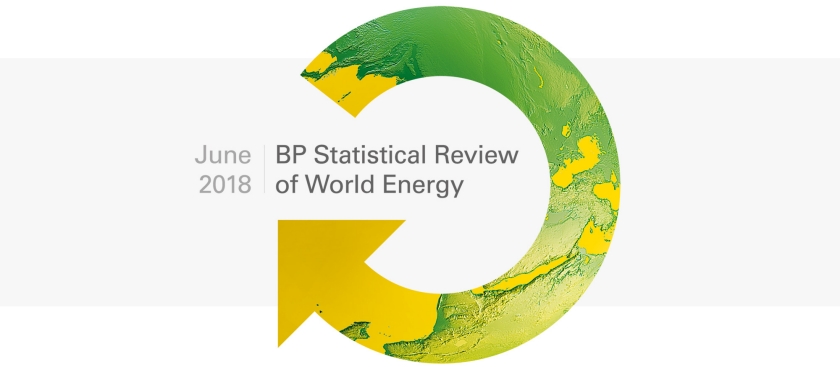For the first time, the BP Statistical Review of World Energy includes data on the fuel mix in the power sector, which strikingly is unchanged from 20 years ago, and key materials (eg, lithium and cobalt) for the changing energy world
 Introducing the 2018 edition of the BP Statistical Review of World Energy, Bob Dudley, BP group chief executive, said: “2017 was a year where structural forces in the energy market continued to push forward the transition to a lower carbon economy, but where cyclical factors have reversed or slowed some of the gains from prior years. These factors, combined with rising demand for energy, has resulted in a material increase in carbon emissions following three years of little or no growth.”
Introducing the 2018 edition of the BP Statistical Review of World Energy, Bob Dudley, BP group chief executive, said: “2017 was a year where structural forces in the energy market continued to push forward the transition to a lower carbon economy, but where cyclical factors have reversed or slowed some of the gains from prior years. These factors, combined with rising demand for energy, has resulted in a material increase in carbon emissions following three years of little or no growth.”
Data published in the Review – the 67th annual edition – show that:
- growth in energy demand increased, led by growing demand for natural gas and renewables,
- gains in energy efficiency slowed as industrial activity in the OECD accelerated and output from China’s most energy-intensive sectors returned to growth,
- coal consumption increased for the first time in four years, led by growing demand in India and China, and
- carbon emissions are estimated to have increased after three years of little to no growth.
 Bob Dudley, Group Chief Executive
Bob Dudley, Group Chief Executive
In 2017 global energy demand grew by 2.2%, above its 10-year average of 1.7%. This above-trend growth was driven by stronger economic growth in the developed world and a slight slowing in the pace of improvement in energy intensity.
Demand for oil grew by 1.8% while growth in production was below average for the second consecutive year. Production from OPEC and the 10 other countries that agreed cuts decreased, while producing countries outside of that group, particularly the US driven by tight oil, saw increases. Consumption exceeded production for much of 2017 and as a result OECD inventories fell back to more normal levels.
2017 was a strong year for natural gas with consumption up 3% and production up 4% – the fastest growth rates since immediately following the global financial crisis. The single biggest factor fueling global gas consumption was the surge in Chinese gas demand, where consumption increased by over 15%, driven by government environmental policies encouraging coal-to-gas switching.
Renewables grew strongly in 2017, with wind and solar leading the way. Coal consumption was also up, growing for the first time since 2013.
Bob Dudley commented: “This year’s Review looks at the energy mix within the power sector, for the first time, which astonishingly shows that the share of coal in the sector is unchanged from 20 years ago. “As we have said in our Energy Outlook, our Technology Outlook and now our Statistical Review, the power system must decarbonize. We continue to believe that gains in the power sector are the most efficient way to drive down carbon emissions in coming decades.”
Review highlights
Primary energy
Primary energy consumption growth averaged 2.2% in 2017, up from 1.2 % last year and the fastest since 2013. This compares with the 10-year average of 1.7% per year. By fuel, natural gas accounted for the largest increment in energy consumption, followed by renewables and then oil.
Energy consumption rose by 3.1% in China. China was the largest growth market for energy for the 17th consecutive year.
Carbon emissions from energy consumption increased by 1.6%, after little or no growth for the three years from 2014 to 2016.
Oil
The oil price (Dated Brent) averaged $54.19 per barrel, up from $43.73/barrel in 2016. This was the first annual increase since 2012.
Global oil consumption growth averaged 1.8%, or 1.7 million barrels per day (b/d), above its 10-year average of 1.2% for the third consecutive year. China (500,000 b/d) and the US (190,000 b/d) were the single largest contributors to growth.
Global oil production rose by 0.6 million b/d, below average for the second consecutive year. US (690,000 b/d) and Libya (440,000 b/d) posted the largest increases in output, while Saudi Arabia (-450,000 b/d) and Venezuela (-280,000 b/d) saw the largest declines.
Refinery throughput rose by an above-average 1.6 million b/d, while refining capacity growth was only 0.6 million b/d, below average for the third consecutive year. As a result, refinery utilisation climbed to its highest level in nine years.
Natural gas
Natural gas consumption rose by 96 billion cubic metres (bcm), or 3%, the fastest since 2010. Consumption growth was driven by China (31 bcm), the Middle East (28 bcm) and Europe (26 bcm). Consumption in the US fell by 1.2%, or 11 bcm.
Global natural gas production increased by 131 bcm, or 4%, almost double the 10-year average growth rate. Russian growth was the largest at 46 bcm, followed by Iran (21 bcm). Gas trade expanded by 63 bcm, or 6.2%, with growth in LNG outpacing growth in pipeline trade.
The increase in gas exports was driven largely by Australian and US LNG (up by 17 and 13 bcm respectively), and Russian pipeline exports (15 bcm).
Coal
Coal consumption increased by 25 million tonnes of oil equivalent (mtoe), or 1%, the first growth since 2013. Consumption growth was driven largely by India (18 mtoe), with China consumption also up slightly (4 Mtoe) following three successive annual declines during 2014-2016. OECD demand fell for the fourth year in a row (-4 mtoe).
Coal’s share in primary energy fell to 27.6%, the lowest since 2004. World coal production grew by 105 mtoe or 3.2%, the fastest rate of growth since 2011. Production rose by 56 mtoe in China and 23 mtoe in the US.
Renewables, hydro and nuclear
Renewable power grew by 17%, higher than the 10-year average and the largest increment on record (69 mtoe).
Wind provided more than half of renewables growth, while solar contributed more than a third despite accounting for just 21% of the total.
In China, renewable power generation rose by 25 mtoe – a country record, and the second largest contribution to global primary energy growth from any single fuel and country, behind natural gas in China.
Hydroelectric power rose by just 0.9%, compared with the 10-year average of 2.9%. China’s growth was the slowest since 2011, while European output declined by 10.5% (-16 mtoe). Global nuclear generation grew by 1.1%. Growth in China (8 mtoe) and Japan (3 mtoe) was partially offset by declines in South Korea (-3 mtoe) and Taiwan (-2 mtoe).
Power generation
Power generation rose by 2.8%, close to the 10-year average. Practically all growth came from emerging economies (94%). Generation in the OECD has remained relative flat since 2010. Renewables accounted for almost half of the growth in power generation (49%), with most of the remainder provided for by coal (44%).
The share of renewables in global power generation increased from 7.4% to 8.4%.
Key materials
Cobalt production has grown by only 0.9% per annum since 2010, while Lithium production has increased by 6.8% p.a. over the same period.
Cobalt prices more than doubled in 2017, while Lithium carbonate prices increased by 37%


